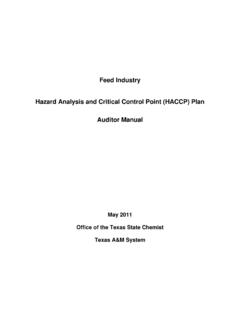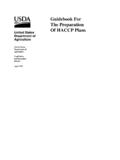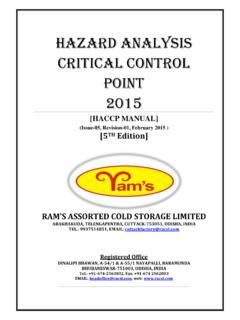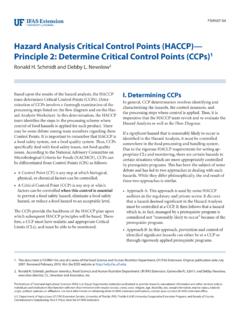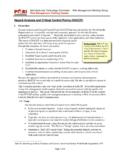Transcription of HACCP SYSTEM Hazard Analysis and Critical Control Point
1 1 HACCP SYSTEM HACCP ( Hazard Analysis and Critical Control Point ) is a systematic preventive approach to the identification, evaluation, and Control of food safety hazards (physical, chemical and biological hazards ), so that key actions, known as CCP ( Critical Control points ) can be taken to prevent, reduce or eliminate the risk. The HACCP SYSTEM , which is science based and systematic, identifies specific hazards and measures for their Control to ensure the safety of food. HACCP is a tool to assess hazards and establish Control systems that focus on prevention rather than relying mainly on end-product testing or customers complaints. Any HACCP SYSTEM is capable of accepting change, such as advances in equipment design, processing procedures or technological developments. HACCP can be applied throughout the food chain from primary production to final consumption (growing, harvesting, processing, manufacturing, distributing, merchandising and preparing food for consumption).
2 Apart from increasing food safety, implementation of HACCP can provide other significant benefits - the application of HACCP systems can aid inspection by regulatory authorities and promote international trade by increasing confidence in food safety. HACCP Team: The group of people who are responsible for developing, implementing and maintaining the HACCP SYSTEM . The 7 HACCP PRINCIPLES: Principle 1: Conduct a Hazard Analysis . A HACCP plan (written document which is based upon the 7 principles of HACCP and which defines the procedures to be followed) determines the food safety hazards and identify the preventive measures the plan can apply to Control these hazards . Principle 2: Determine the Critical Control points (CCPs). CCP is a Point , step or procedure in food manufacturing process at which Control can be applied and, as a result, a food safety Hazard can be prevented, eliminated or reduced to an acceptable level.
3 Principle 3: Establish Critical limits. A Critical limit is the maximum or minimum value to which a physical, biological or chemical Hazard must be controlled at a Critical Point . Principle 4: Establish monitoring procedures. Monitoring activities are necessary to ensure that the process is under Control at each CCP. Each monitoring procedure and its frequency has to be listed in the HACCP plan. Observations are planned and accurate records have to be produced for future use in verification. Principle 5: Establish corrective actions. These are actions to be taken when monitoring indicates a deviation from an established Critical limit. The corrective actions are taken if a Critical limit is not met. 2 Principle 6: Establish verification / validation procedures. Verification activities (review of: HACCP plan, CCP records, Critical limits, microbial sampling and Analysis ) determine that the SYSTEM is operating according to the plan.
4 Verification tasks have to be performed by the plant personnel. Validation is an element of verification focused on collecting and evaluating scientific and technical information to determine if the HACCP plan, when properly implemented, will effectively Control the hazards . Principle 7: Establish record-keeping and documentation procedures. All plants have to maintain certain documents, including its Hazard Analysis , written HACCP plan, records documenting the monitoring of CCPs, Critical limits, verification activities and the handling of processing deviations. 3 An example of a HACCP plan: 4 EXERCISES 1. Use to following picture to describe the main characteristics of the HACCP SYSTEM . 2. Translate. preverjanje prito ba strank vzdr evanje sistema tveganje preventiva odstopanje ukrepi etev 3.
5 Complete the following sentences. 1. HACCP stands for Hazard _____ and _____ Control _____. 2. HACCP is an _____ tool it is recognized in many different countries. 3. The group of people who are responsible for developing and maintaining the SYSTEM are called a _____. 4. One of the HACCP principles is to establish _____ - it usually means that we fix a numerical limit to them. 5. A CCP is _____. Viri: #princ (Pridobljeno: ) (Pridobljeno: ) #imgrc=1-POFB9_vq25JM%3A (Pridobljeno: ) (pridobljeno ( ) ( ))






